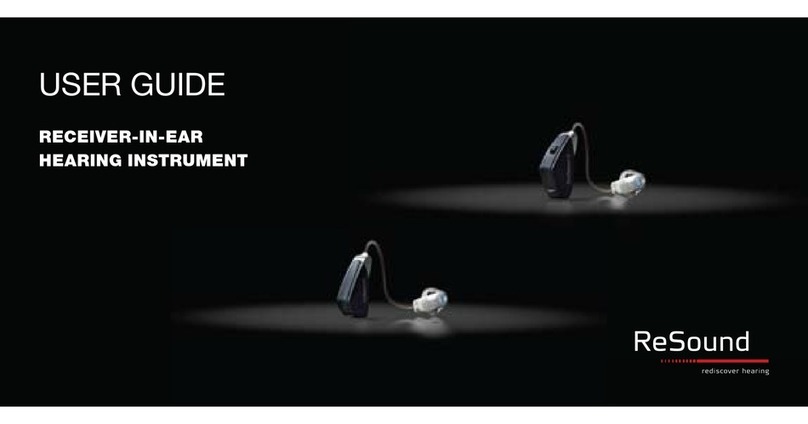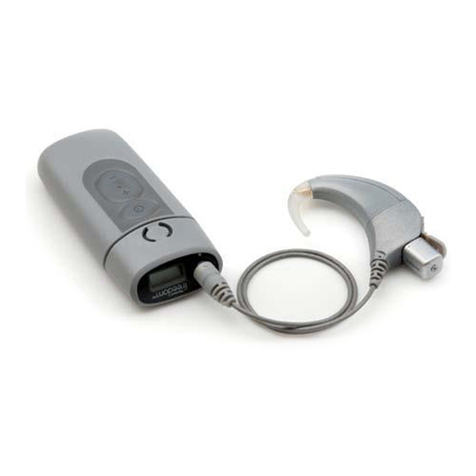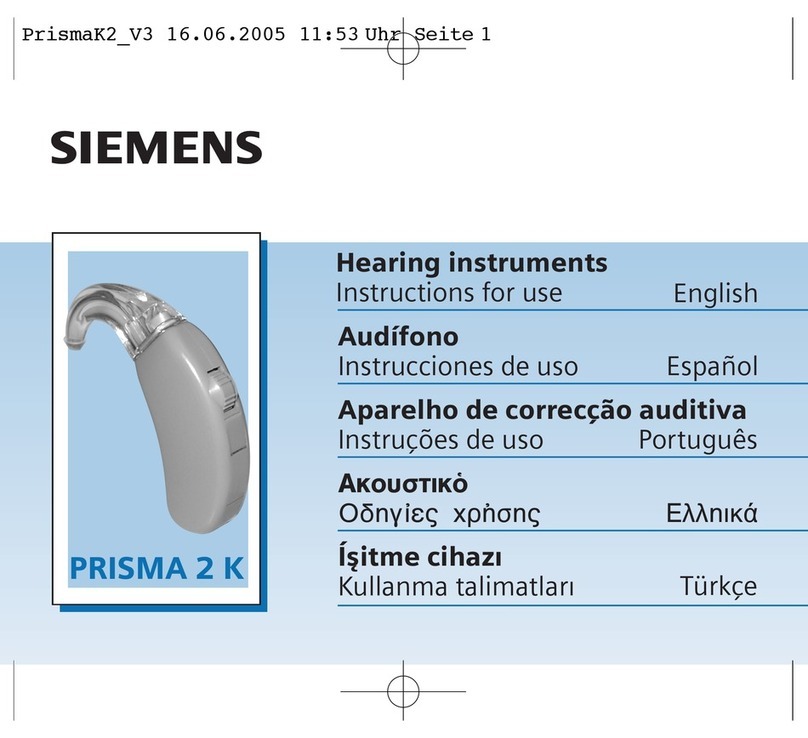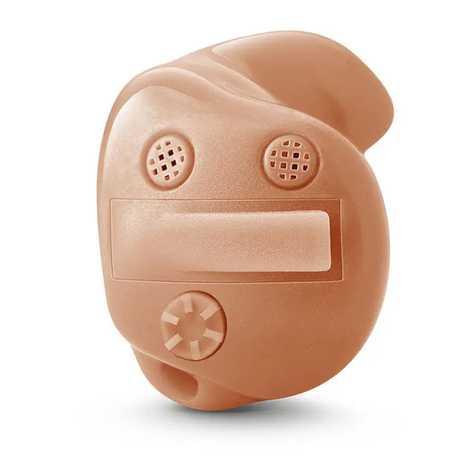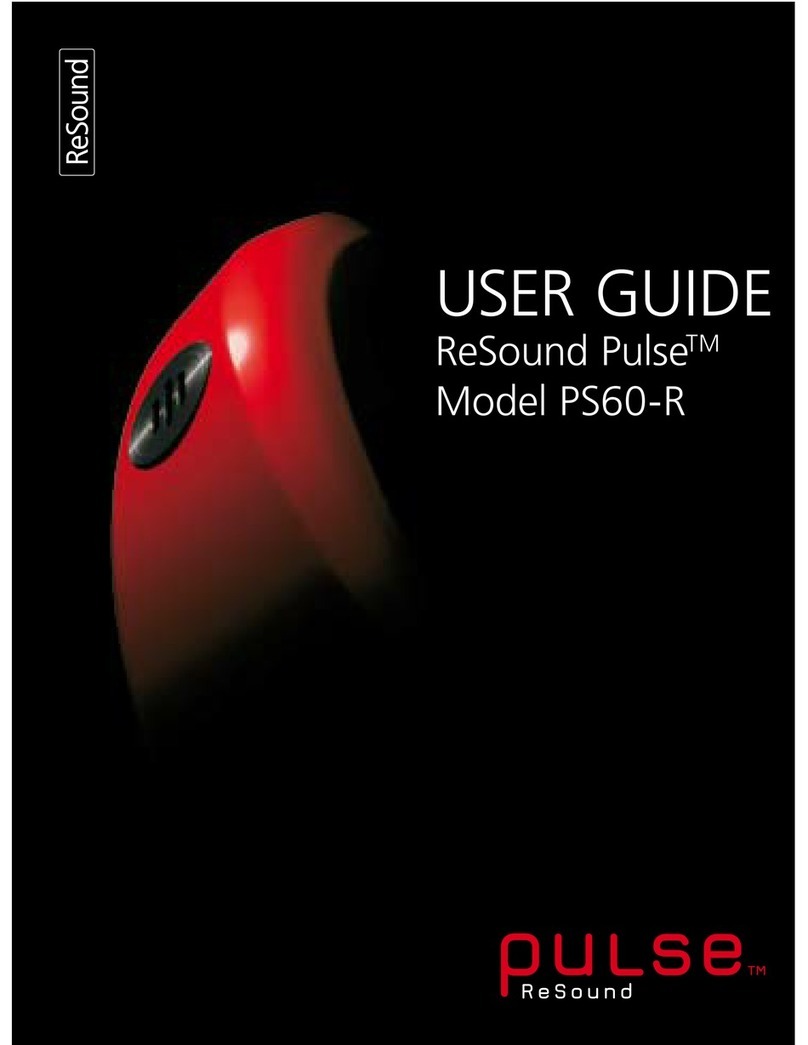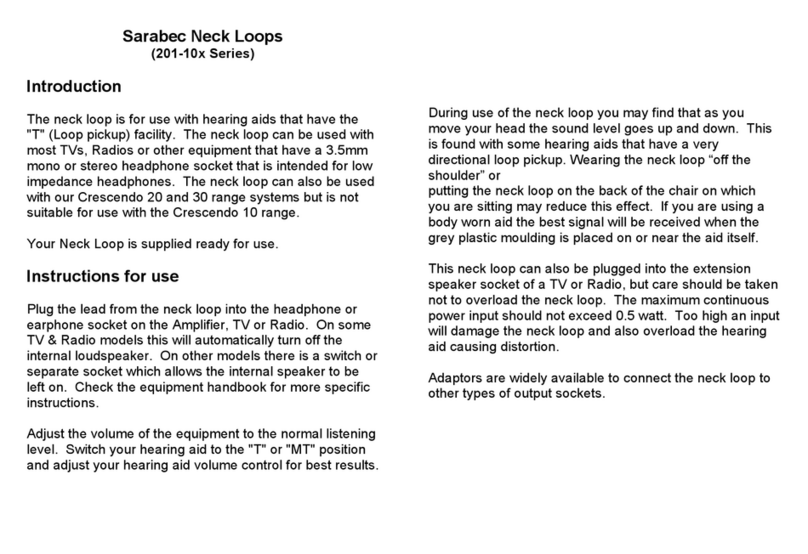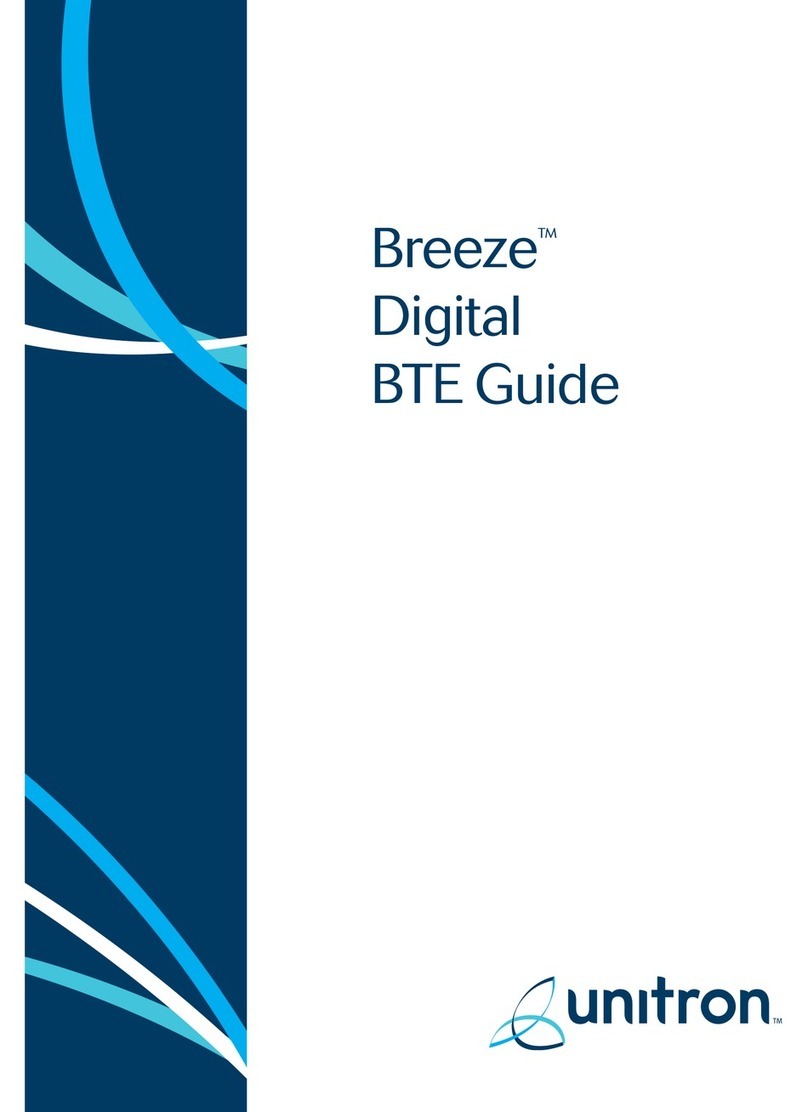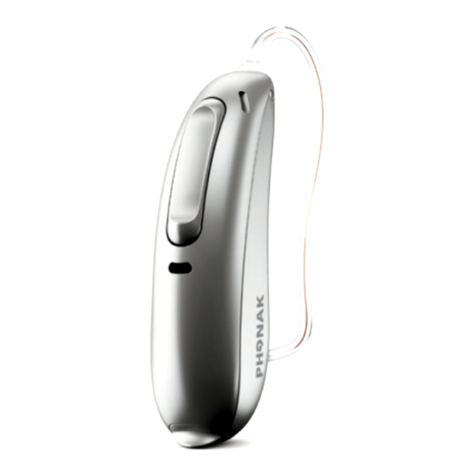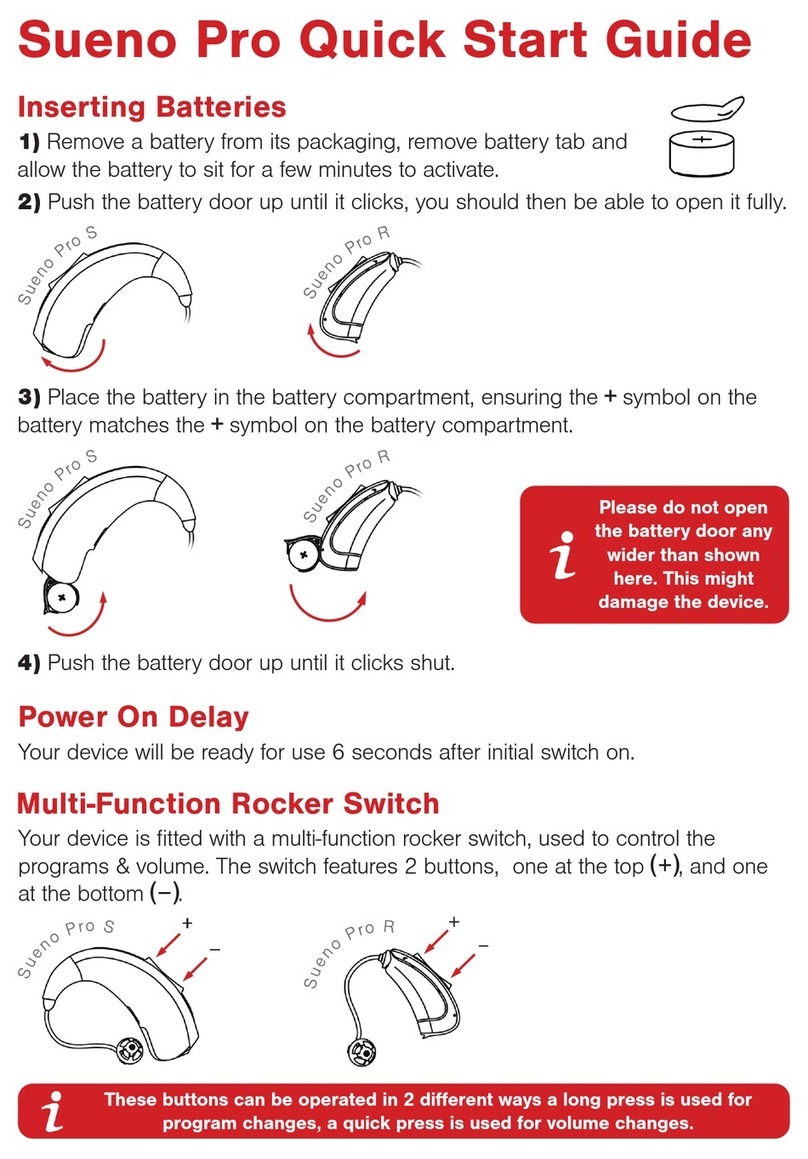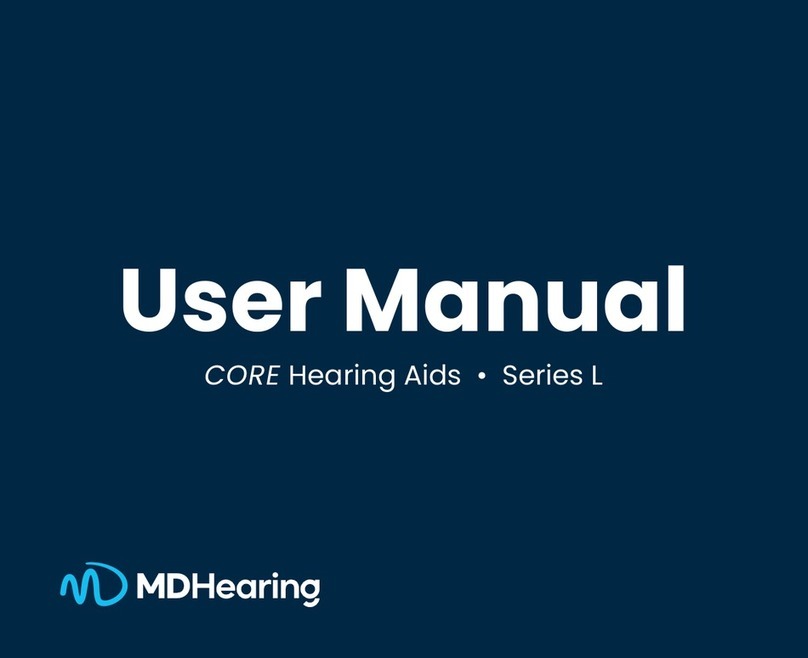OTC Audien BTE User manual

1
OTC
Audien BTE
U S E R M A N U A L

2.WARNING:When to see a doctor
If you have any of the problems listed below, please see a doctor, preferably an ear-nose-throat doctor (an
ENT).
●Your ear has a birth defect or an unusual shape. Your ear was injured or deformed in an accident.
● You saw blood, pus, or fluid coming out of your ear in the past 6 months.
●Your ear feels painful or uncomfortable.
● You have a lot of ear wax, or you think something could be in your ear.
● You get really dizzy or have a feeling of spinning or swaying (called vertigo).
This OTC hearing aid is for users who are 18 and older. People who are younger than 18 with hearing loss
should see a doctor, preferably an ENT,because they may need medical testing and management. Hearing loss
can affect speech and learning, so professional fitting and continuing care are also important.
1.WARNING:If you are younger than 18,do not use this.
You should go to a doctor, preferably an ear-nose-throat doctor(an ENT), because your condition needs
specialized care. Over-the-counter hearing aids are only for users who are age 18 or older.
WARNING
●Your hearing changed suddenly in the past 6 months.
● Your hearing changes: it gets worse then gets better again
● You have worse hearing in one ear
● You hear ringing or buzzing in only one ear.
3.WARNING:This hearing aid should not cause pain when inserting it.
Remove this device from your ear if it causes pain or discomfort when you insert or place it. To try again,
make sure to follow the instructions. If you feel pain or discomfort again, contact the manufacturer. If your
pain or discomfort doesn't go away, contact your hearing healthcare professional. You can also report this to
FDA as an adverse event according to the instructions that appear later.
4.Caution: This is not hearing protection.
You should remove this device if you experience overly loud sounds, whether short or long-lasting. If you're in
a loud place, you should use the right kind of hearing protection instead of wearing this device. In general, if
you would use ear plugs in a loud place, you should remove this device and use ear plugs.
5.Caution: The sound output should not be uncomfortable or painful.
You should turn down the volume or remove the device if the sound output is uncomfortably loud or painful.
If you consistently need to turn the volume down, you may need to further adjust your device.

WARNING
6.Caution: You might need medical help if a piece gets stuck in your ear.
If any part of your hearing aid, like the eartip, gets stuck in your ear, and you can't easily remove it with your
fingers, get medical help as soon as you can. You should not try to use tweezers or cotton swabs because they
can push the part farther into your ear, injuring your eardrum or ear canal, possibly seriously.
7.Note: If you remain concerned, consult a professional.
If you try this device and continue to struggle with or remain concerned about your hearing, you should
consult with a hearing healthcare professional.
8.Note: What you might expect when you start using a hearing aid.
A hearing aid can benefit many people with hearing loss. However, you should know it will not restore normal
hearing, and you may still have some difficulty hearing over noise. Further, a hearing aid will not prevent or
improve a medical condition that causes hearing loss.
People who start using hearing aids sometimes need a few weeks to get used to them. Similarly, many people
find that training or counseling can help them get more out of their devices.
If you have hearing loss in both ears, you might get more out of using hearing aids in both, especially in situa-
tions that make you tired from listening — for example, noisy environments.
Follow all the facility rules and posted instructions in areas where wireless network use its prohibited.
9.Note: Tell FDA about injuries, malfunctions, or other adverse events.
To report a problem involving your hearing aid, you should submit information to FDA as soon as possible
after the problem. FDA calls them "adverse events," and they might include: skin irritation in your ear, injury
from the device(like cuts or scratches, or burns from an overheated battery), pieces of the device getting
stuck in your ear, suddenly worsening hearing loss from using the device, etc.
Instructions for reporting are available at https:/www.fda.gov/Safety/MedWatch, or call 1-800-FDA-1088.
You can also download a form to mail to FDA.
10. Intended use
●The Hearing Aids are used for hearing compensation of patients with mild to moderate air conduction
hearing loss.
11. Contraindication
●The device is unsuitable and should not be used in the following situations:
(1) Patients with chronic suppurative otitis media, congenital ear atresia to banned use.
(2) This hearing aids only be used for compensating the patients with hearing impairment, do not have
hearing therapeutic value.

1
It’s time to
hear again.
Device Diagram
Package Contents
Setting Up Your Device
Fitting Your Ear Domes
Switching Between Modes
Adjusting Volume
Inserting Into Ear
Power On/Off
Charging Your Device
Light Key
Cleaning Your Device
Dome & Product Cleaning
Product Care
Precautions
TA B L E OF C ONTENT S
1, 2
3
4-8
4
5
6
7
8
9
10
11-16
11, 12
13-16
17,18
19
Regulatory and Legal Information 20-30

12
DEVICE DIAG R AM
Charging Case Cover
Left Charging Port
Right Charging Port
Charging Indicator
Light for Left Ear
(Light 1)
Charging Indicator
Light for Right Ear
(Light 3)
Charging Indicator
Light for Charging
Case (Light 2)
Ear Tube
Ear Dome
Receiver
Microphone 1
Microphone 2
Magnetic Charging
Connection Point
Volume Up
(Press for 1 second)
Mode Switch (Press for 3 seconds)
Volume Down
(Press for 1 second)
Turn On/Off (Press for 3 seconds)
Red = Right Ear

SE TTING UP YOUR D E VICE
4
PACKAGE CONTENT S
Fitting Your Ear Domes
Your Audien BTE comes with small, medium and large sizes of
Ear Domes. To remove an EarDome from your device, simply
pull with enough force until it pops off. To attach, hold on to the
fastened securely.
Replace the domes as needed. Choosing the dome size most suitable for your needs will
provide a much better experience using your Audien BTE.
3

5
ADJUSTING THE VOLUME
Switching between Modes Adjusting Volume
To change between the 4 environmental modes on your Audien
BTE, press on the volume up button for 3 seconds. The amount of
beeps that you hear after the 3 seconds indicates which mode you
are on.
Higher volume:
Press the volume up button for 1 second to increase the volume.
Lower volume:
Press the volume down button for 1 second to decrease the volume.
6
Mode
M1 Conversation 1 Beep
M2 Restaurant 2 Beeps
M3 Outdoor 3 Beeps
M4 Music 4 Beeps
Suitable for Indicator
There are 11 volume levels. You will hear 1 beep each time you move up
or down a level. You will hear 2 beeps when you reach the highest/lowest
setting.

8
7
SE TTING U P YOUR DEVICE
Step 1: Insert the ear dome into your ear canal.
Step 2: Gently wrap the Audien BTE over your ear
until it rests securely behind your ear.
Step 3: Push the ear tube into your ear canal until it is
snug and comfortable.
Inserting Into Ear
Powering ON/OFF
There are two methods to turn the Audien BTE on or off.
Turn on: Remove the Audien BTE from the charging case, and it will
automatically turn on.
Turn off: Place the Audien BTE back into its charging port, and it
will automatically turn off.
Press the volume down button for 3 seconds to turn the Audien
BTE on or off. You will hear an indicator sound saying, “Power On”
or “Power Off.”
1
2
3
1.
2.

10
CHARGING YOURDEVICE
9
Step 1
Plugthe chargingcase
and USBcable into a
standard outlet. Light
2 will flash blue to
indicate the product
is charging.
Step 2
Insert the Audien BTE units
into the charging port.
The left ear unit should be
inserted into left charging
port. The right ear unit should
be in right charging port. Light
1 and light 3 will turn blue to
indicate charging.
Step 3
It will take around 2 hours
to fully charge both Audien
BTE units and their charging
case. On average, a full charge
lasts 20 hours. The case has
an internal battery so you can
charge your devices on the go.
Charging Your Device
CHARGE TIME: 2 HOURS
Blue lights indicate charging
(Light 1 & 3 )
LIGHT KEY:
Light 1
solid white =
Left ear fully charged
Light 3
solid white =
Right ear fully charged
Light 2 solid blue =
Charging case fully charged

11
CLEANING YOURDEVICE
Cleaning Your Device
Dome Cleaning
Use the included cleaning brush to remove earwax, dust, and any
other debris from domes.
Audien BTE Cleaning
Use a soft cloth or tissue to clean the body of the Audien BTE,
including the push buttons, charging contacts, shell, etc. Do not use
alcohol, water, or other cleaning solvents to clean the Audien BTE
as it may damage them.
Regular cleaning is necessary. You may contact
us by email at: support@audienhearing.com to
order new domes and other accessories.
12

13
CLEANING YOURDEVICE
Product Care:
14
-Keep your Audien BTE and charging case clean. Extreme temperatures (hot or cold), moisture,
and foreign substances may damage the product.
-Regular cleaning is necessary.
-Charging contacts should always be kept clean and dry.
-Using the provided cleaning brush keep the charging ports clear of dust or dirt.

16
CLEANING YOURDEVICE
15
Ear Dome
Take the ear dome off &
make sure to clean any
ear-eax buildup under
the ear dome.
-Keep the lid closed as much as possible to avoid dust and debris build up.
-Store your charger in a clean and dry location, i.e., a dresser or shelf rather than the
bathroom or kitchen.
-Do not remove the batteries from the Audien BTE or charging case
-Recharge the Audien BTE and charging case at least once a week. No power for extended
periods of time may damage the battery.
Product Care Continued:

18
TE CHNICAL SPE C IFICATION S
17
Item
Charging box Input voltage
Charging box Input current
Charging box Output current
Working Voltage
Charging box Output voltage
Charging Case
d.c.5.0V
1A
80mA
d.c.3.7V
d.c.4.2V
Max Output (OSPL90)
Full-on gain value (HFA FOG@50)
Latency value
Frequency response bandwidth F1<200Hz
F2=7100Hz
110dB
37dB
Total harmonic distortion value 0.70%
Self-generated noise value 18dB
6ms
Frequency response smoothness
2dB
Disposal
Please dispose of the device in accordance with the
directive 2002/96/EC – WEEE (Waste Electrical
and Electronic Equipment). If you have any
questions, please refer to your local authority
responsible for waste disposal.

20
PRECAUTIONS
19
REGULATORY AND LEGAL INFORMATION
With the increased number of electronic devices such as PC and mobile (cellular) telephones, radio trans-
ceivers, mobile radio transmitters, radio-controlled toys, and so on, Medical devices in use may be suscep-
tible to electromagnetic interference from other device. Electromagnetic interference may result in
incorrect operation of the medical devices and create a potentially unsafe situation. Medical devices
should also not interfere with other devices.
In order to regulate the requirements for EMC (Electro Magnetic Compatibility) with the aim to prevent
unsafe product situations, the EN60601-1-2 standard has been implemented. This standard defines the
levels of immunity to electromagnetic interference as well as maximum levels of electromagnetic emis-
sions for medical devices.
This unit has been thoroughly tested and inspected to assure proper performance and operation! This
product needs special precautions regarding EMC and needs to be installed and put into service accord-
ing to the EMC information provided, the following tables recommend minimum separation distances
between portable and mobile RF communications equipment and the RJADAT-1 unit.
This information and other labeling, including the
user instructional brochure, are available on the internet at:
You may also call 205-255-1112 or write to [email protected] or
10733N FLW Blvd#103, Scottsdale, AZ85259 to request a paper copy of this information &
other labeling.
Manufacturer's return policy
Audien has a 45 day return policy from the day you receive your shipment. As long as you request a return
within the 45 day period, you will be provided a return shipping label by Audien's support team after going
through the Ship Station returns process. You must drop off your package at the post office and have it
show as “accepted” in the tracking information by the 45th day to be eligible for a refund.
Any returns dropped to the post office past the 45 day mark are not eligible for a refund. Once the pack-
age has been received by our team, your refund will be processed within approximately 3 business
days.Once processed,are fund typically takes 3-5 business days to reach your bank account.
Important information regarding Electro Magnetic Compatibility (EMC)

2221
LEGAL INFORMATION
Guidance and manufacturer’s declaration-electromagnetic emission
Electromagnetic
environment – guidance
Emission test
Power line
conducted
emission
test
CISPR 11,
Class B,
Group 1
N/A
Classified / Test Level Compliance
Hearing aids use RF energy
only for its internal
function. Therefore, its RF
emissions are very low and
are not likely to cause any
interference in nearby
electronic equipment.
Hearing aids are intended for use in the electromagnetic environment specified below. The customer
of the user of hearing aids should assure that it is used in such an environment.
Voltage
fluctuations
& flicker
emissions
IEC
61000-3-3 N/A
Radiated
emission
test
CISPR 11,
Class B ,
Group 1
Pass
Harmonic
crurent
emission
test
IEC
61000-3-2,
Class A
N/A
The hearing-aids are
suitable for use in all
establishments, other
domestic establishments
and those directly
connected to the public
low-voltage power supply
network that supplies
buildings used for
domestic purposes.
1. Guidance and manufacture’s declaration - electromagnetic emission-for all EQUIPMENT and
SYSTEMS.

24
23
Guidance and manufacturer’s declaration-electromagnetic immunity for all equipment and systems.
Immunity test IEC 60601 test level Compliance level
Hearing aids are intended for use in the electromagnetic environment specified below. The customer
or the user of hearing aids should assure that it is used in such an environment.
LEGAL INFORMATION
Electrostatic
discharge
(ESD) IEC
61000-4-2
Contact discharge:
±2 kV, ±4 kV,
±6 kV, ± 8 kV
Air discharge:
±2 kV, ±4 kV,
±8 kV, ±15 kV
Contact discharge:
±2 kV, ±4 kV,
±6 kV, ± 8 kV
Air discharge:
±2 kV, ±4 kV,
±8 kV, ±15 kV
Radiated RF
electromagnetic
fields immunity test
10V/m,80MHz
-2.7GHz 80% AM at 1KHz
RF Band (IEC
60601-1-2:2014+
A1:2020 section 8.10 table 9)
10V/m,80MHz
-2.7GHz 80% AM at 1KHz
RF Band(IEC
60601-1-2:2014+
A1:2020 section 8.10 table 9)
Electrical fast
transient and
burst test
IEC 61000-4-4
AC port:±2 kV
Patient coupling
port:±1 kV
100kHz repetition frequency
N/A
Surge test
IEC 61000-4-5
Line to line: ±500V, ±1kV
Line to ground:
±500V,±1kV,±2 kV
N/A
Power frequency
(50Hz/60Hz)
magnetic field
IEC61000-4-8
30 A/m, 50Hz and 60Hz 30 A/m, 50Hz and 60Hz
2. Guidance and manufacture’s declaration - electromagnetic immunity-for all EQUIPMENT
and SYSTEMS.

26
25
LEGAL INFORMATION
Guidance and manufacturer’s declaration-electromagnetic immunity for equipment and system
that are not life-supporting.
The hearing aids are intended for use in the electromagnetic environment specified below. The customer
or the user of hearing aids should assure that it is used in such an environment.
Voltage dips,
and interruption
IEC 61000-4-11
Proximity
magnetic fields
immunity test
NOTE: UT is the a.c. mains voltage prior to application of the test level.
0% UT; 0.5 cycles At 0°,
45°, 90°, 135°,
180°, 225°, 270° and 315°
N/A0% UT; 1cycle and 70% UT;
25 cycles
Single phase: at 0°
0% UT; 250 cycles
IEC 60601-1-2:
2014+A1:2020
section 8.11 table 11
IEC 60601-1-2:
2014+A1:2020
section 8.11 table 11
Immunity test
IEC 60601 test level
Compliance level
Conducted RF IEC
61000-4-6
Radiated RF IEC
61000-4-3
10 Vrms
150 kHz to 80 MHz
10V/m
80 MHz to 2.5 GHz
10 Vrms 10V/m
80 MHz to 2.5 GHz
3. Guidance and manufacture’s declaration – electromagnetic immunity-for EQUIPMENT and
SYSTEM that are not LIFE-SUPPORTING.

28
27
LEGAL INFORMATION
Electromagnetic
environment –
guidance
Portable and mobile RF communications equipment should be used no closer to any
part of hearing aids, including cables, than the recommended separation distance
calculated from the equation applicable to the frequency of the transmitter.
NOTE 1 At 80 MHz and 800 MHz, the higher frequency range applies.
NOTE 2 These guidelines may not apply in all situations. Electromagnetic propagation is affected by
absorption and reflection from structures, objects and people.
Field strengths from fixed transmitters, such as base stations for radio (cellular/cordless) telephones
and land mobile radios, amateur radio, AM and FM radio broadcast and TV broadcast cannot be
predicted theoretically with accuracy. To assess the electromagnetic environment due to fixed RF
transmitters, an electromagnetic site survey should be considered. If the measured field strength in the
location in which hearing aids are used exceeds the applicable RF compliance level above, hearing aids
should be observed to verify normal operation. If abnormal performance is observed, additional
measures may be necessary, such as reorienting or relocating hearing aids.
Over the frequency range 150 kHz to 80 MHz, field strengths should be less than 3 V/m.
Interference may occur in the vicinity of equipment marked with the following
symbol:
Where P is the maximum output power rating of the transmitter in watts (W)
according to the transmitter manufacturer and d is the recommended separation
distance in meters (m).
Field strengths from fixed RF transmitters, as determined by an electromagnetic
site survey, should be less than the compliance level in each frequency range.
Recommended separation distance
ab
a
b

30
29
Hearing aids are intended for use in an electromagnetic environment in which radiated RF disturbances
are controlled. The customer or the user of hearing aids can help prevent electromagnetic interference
by maintaining a minimum distance between portable and mobile RF communications equipment
(transmitters) and hearing aids as recommended below, according to the maximum output power of the
communications equipment.
4. Recommended separation distances between portable and mobile RF communications
equipment and hearing aids.
Rated maximum
output power of
transmitter (W)
Separation distance according to frequency of transmitter (m)
150 KHz to 80 MHz 80 MHz to 800 MHz 800 MHz to 2.5 GHz
0.01 0.12 0.12 0.23
0.1 0.38 0.38 0.73
1 1.2 1.2 2.3
10 3.8 3.8 7.3
100 12 12 23
For transmitters rated at a maximum output power not listed above, the recommended separation
distance in meters (m) can be estimated using the equation applicable to the frequency of the transmitter,
where P is the maximum output power rating of the transmitter in watts (W) according to the transmitter
manufacturer.
NOTE 1: At 80 MHz and 800 MHz, the separation distance for the higher frequency range applies.
NOTE2: These guidelines may not apply in all situations. Electromagnetic propagation is affected by
absorption and reflection from structures, objects and people.
LEGAL INFORMATION
Table of contents
Other OTC Hearing Aid manuals


